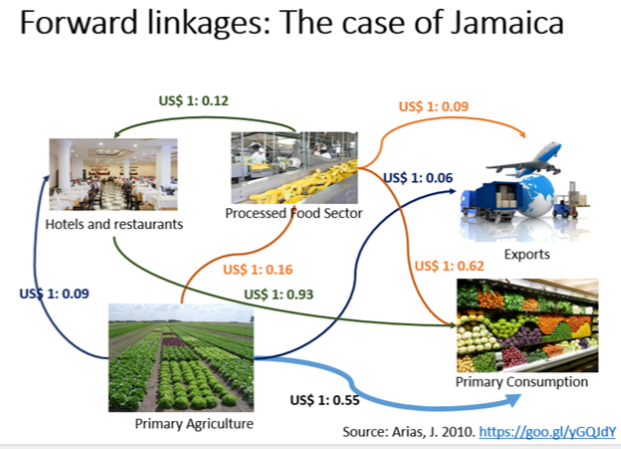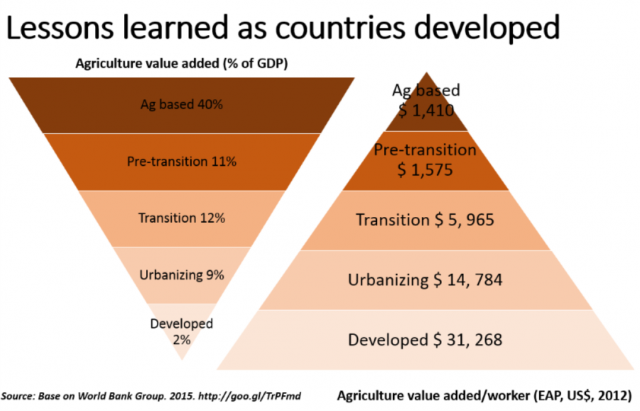The Contribution of Agriculture to Development

By Dr. Joaquín Arias, Policy and Sectoral Analysis Specialist, IICA, joaquin.arias@iica.int
The measure of agricultural output as the Agricultural Gross Domestic Product (AgGDP) does not include the agribusiness sector, neither the agricultural forward and backward linkages with the rest of the economy, nor the multiplier effect of the sector through income changes. Beyond those so called input-output linkages, traditional statistics about agriculture say very little about agriculture’s contribution to rural development, poverty reduction, food security, nutrition, biodiversity, and environmental sustainability. Furthermore, the conventional measurement of growth in agriculture does not reflect changes in income, but changes in the physical volumes of output only. Such growth indicators (rendered in constant prices) provide only a partial view of agriculture’s performance. This can create serious discontent among farmers since their income can actually decrease as a result of the lower prices even when output increases (see for more details Paz, Benavides, & Arias, 2009).
Recognizing and correctly valuing the performance, critical importance and increasing role of agriculture in economic development have important implications for public sector budgetary allocations and actual expenditures in agriculture, which continue to be low and inadequate. Since the performance of agriculture has been measured using information about actual output and the sale of raw materials (mainly volumes of fresh produce or crops harvested, livestock slaughtered and fish produced/landed), the sector’s contribution to the country’s economic development is highly undervalued.
In a pioneer effort to overcome measurement problems, IICA introduced in 2004 (Trejos, Arias, Segura, & Vargas, 2004) the concept of expanded agriculture, which is an accounting procedure that adds to the traditional measure of agriculture GDP (agriculture, forestry and fishing), the GDP generated by manufacture activities linked to the primary agricultural sector. Citing Jamaica as an example, primary-agriculture GDP during the period of 2004-2008 was 5.07% of overall GDP, but when adding the manufacture sector linked to agriculture, the contribution of expanded agriculture went up to 9.9%, an increase in the contribution of agriculture by a ratio of 1.95 (J. Arias, 2010). By comparison, the ratio of the contribution of expanded agriculture to the contribution of primary AgDP was 2.9 for Costa Rica and 11.6 for the United States (Trejos et al., 2004). In other words, it triples for Costa Rica and it is close to 12 times higher for the United States.
It needs to be recognized, however, that as a country moves from a stage of agriculture-based development (more than 50% workforce in agriculture) to urbanization (10-25% workforce in agriculture) to developed (less than 10% workforce in agriculture), either the percentage share of primary agriculture or the percentage share of expanded agriculture to GDP will decrease significantly. In agriculture-based countries, the agriculture share can be as high as 50% of overall GDP, down to near 20% in urbanizing countries, and further down to less than 10% in developed countries. This is because other sectors of the economy, especially the service sector, become much more dynamic, therefore growing faster especially in countries entering higher stages of development. It does not mean, though, that the agriculture or agribusiness sectors, become less important. In fact, in agriculture-based countries, for every dollar generated on the farm, another 56 cents is generated in the agribusiness sector (a 1:0.56 ratio). That multiplier increases to 1:1.17 in urbanizing countries and to 1:1.90 in developed countries (World Bank Group, 2015). In other words, primary agriculture in countries like the United States can contribute far less than 1% to overall GDP, but one dollar of primary agriculture generates close to 2 dollars in agribusiness valued added.

Another way to visualize the contribution of agriculture to development is by measuring forward linkages with other sectors of the economy. Forward linkages mean economic activity generated beyond the farm as products move along the supply chain to final consumers. Citing again the case of Jamaica, for every dollar generated on the farm, 55 cents goes directly to primary consumption, in a sense, missing opportunities along the supply chain to add more value. Only 16 cents per dollar goes to the processed food sector, which in turn sells 62 cents for every dollar of output to final consumers, 12 cents to hotels and restaurants while 9 cents per dollar is exported. A similar exercise can be done with backward linkages or the valued added generated in sectors that served as the source of inputs and services for agriculture (chemicals, transportation, energy and financial sector). Over time, policies and incentives should be implemented to stimulate more value added activities so that the economic impact of every dollar generated at the farm level increases.

Furthermore, as countries developed, agriculture value added per worker increases significantly. This is mainly due to increases in productivity, knowledge and capital intensification in agriculture. It is observed that average agriculture value added per worker is as low as USD 1,410 in agriculture-based countries, increases to USD 14,784 in urbanized countries on average, and is on average as high as USD 31,268 in developed countries. So the share of primary agriculture to overall GDP, as well as relative employment in agriculture, decreases significantly over time, while per worker agriculture capital stock and value added increases. This explains why a shrinking agriculture sector (in relative terms) is a major source of increasing income and living standards in rural areas, an important source of inputs for the industry, and produces enough food for a fast growing urban population all over the world.

Higher agricultural valued added per worker implies that more income is generated from agriculture which contributes to lower levels of poverty in rural areas. Lower poverty rates in rural territories is also associated with more production and income diversification and with more market oriented economies (D. Arias et al., 2014). Income diversification provides higher off-farm income alternatives that complement agricultural activities, like the service-related, tourism activities in the rural areas of Costa Rica. Higher valued added, product diversification and export oriented non-traditional products, on the other hand, are linked to lower levels of poverty in the rural Chile.
In light of the facts presented, the challenge ahead is to design effective policies to increase productivity, promote value-added agriculture, increase income and product diversification in rural territories, and to promote market-oriented policies. The allocation of more public resources to achieve the same must come from recognizing, measuring and valuing agriculture in its right dimensions, beyond what traditional statistics show.
This is a summary of a presentation delivered in January 2016 at the Regional Planners Forum on Agriculture – Policy Orientation/Training for Component 1: Strengthening Regional Agricultural Development Policy and Strategy Implementation of the Intra-ACP APP Project, funded under the 10th European Development Fund (EDF).
References
Arias, D., Coello, B., Arias, J., Giertz, A., Edmeades, S., Bandura, R., … Msellati, L. (2014). Agriculture for Nutrition in Latin America and the Caribbean : From Quantity to Quality. (D. Arias, Ed.). Washington DC: International Bank for Reconstruction and Development. Retrieved from https://goo.gl/OseFZY
Arias, J. (2010). The Contribution of Agriculture to Sustainable Development in Jamaica. San Jose, Costa Rica: IICA. Retrieved from https://goo.gl/yGQJdY
Paz, J., Benavides, H., & Arias, J. (2009). Measuring agricultural GDP performance: a technical note. COMUNIICA. Retrieved from http://goo.gl/TrPFmd
Trejos, R., Arias, J., Segura, O., & Vargas, E. (2004). More Than Food on the Table : Agriculture ’ S True Contribution. San Jose, Costa Rica: IICA. Retrieved from https://goo.gl/0Z9Onc
World Bank Group. (2015). Enabling the business of agriculture. Washington DC: World Bank Group. Retrieved from www.worldbank.org
*The opinions expressed in this newsletter are those of the authors and they do not reflect the position of the Institute on the topics presented.
This post appears in the IICA Delegation in the USA Newsletter - January - February 2016